seats MERCEDES-BENZ M-Class 2015 W166 Owner's Manual
[x] Cancel search | Manufacturer: MERCEDES-BENZ, Model Year: 2015, Model line: M-Class, Model: MERCEDES-BENZ M-Class 2015 W166Pages: 466, PDF Size: 8.92 MB
Page 5 of 466
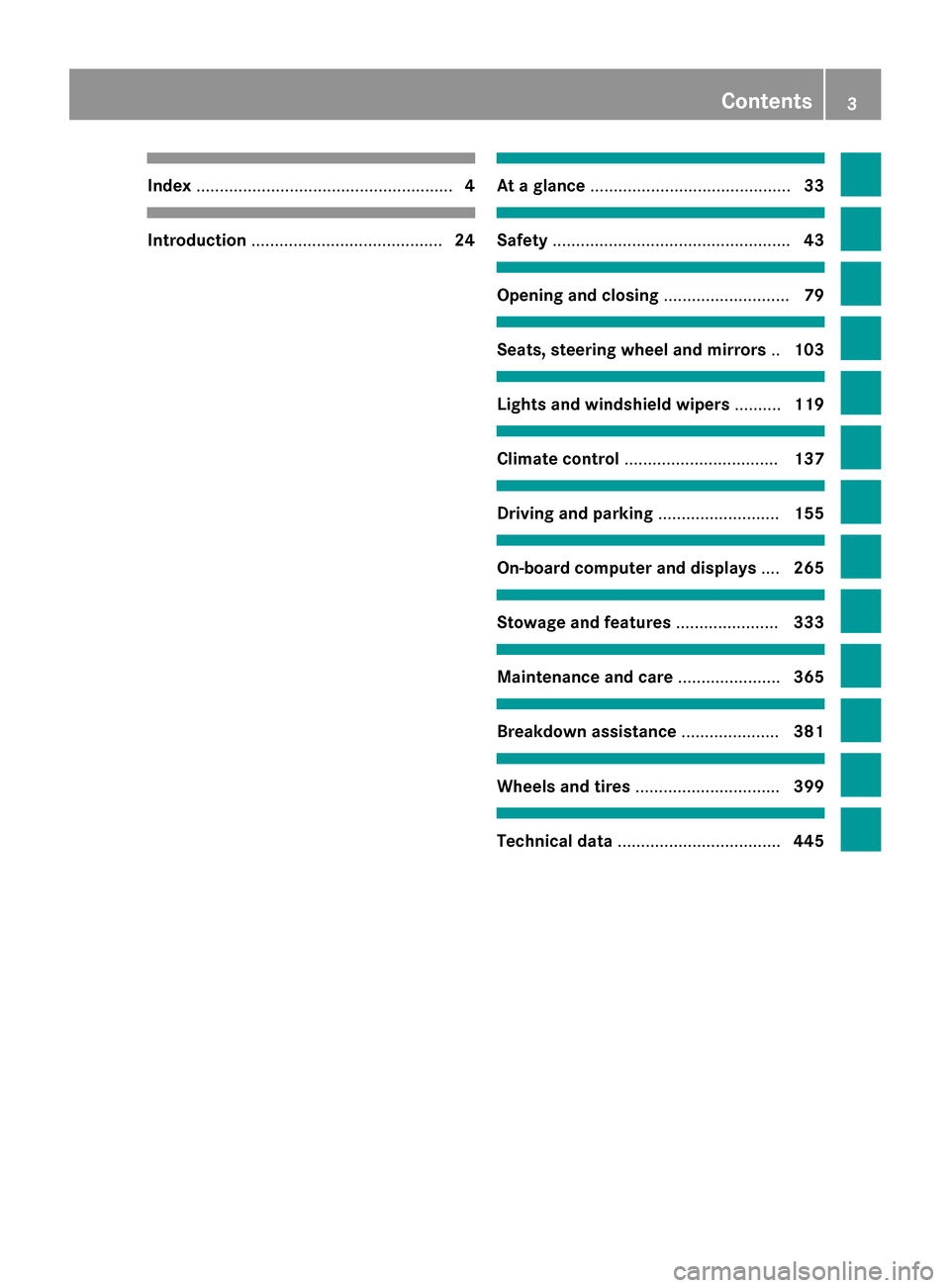
Index
....................................................... 4Introduction
......................................... 24 At a glance
........................................... 33 Safety
................................................... 43 Opening and closing
...........................79 Seats, steering wheel and mirrors
..103 Lights and windshield wipers
..........119 Climate control
................................. 137 Driving and parking
..........................155 On-board computer and displays
....265 Stowage and features
......................333 Maintenance and care
......................365 Breakdown assistance
.....................381 Wheels and tires
............................... 399 Technical data
................................... 445 Contents
3
Page 19 of 466
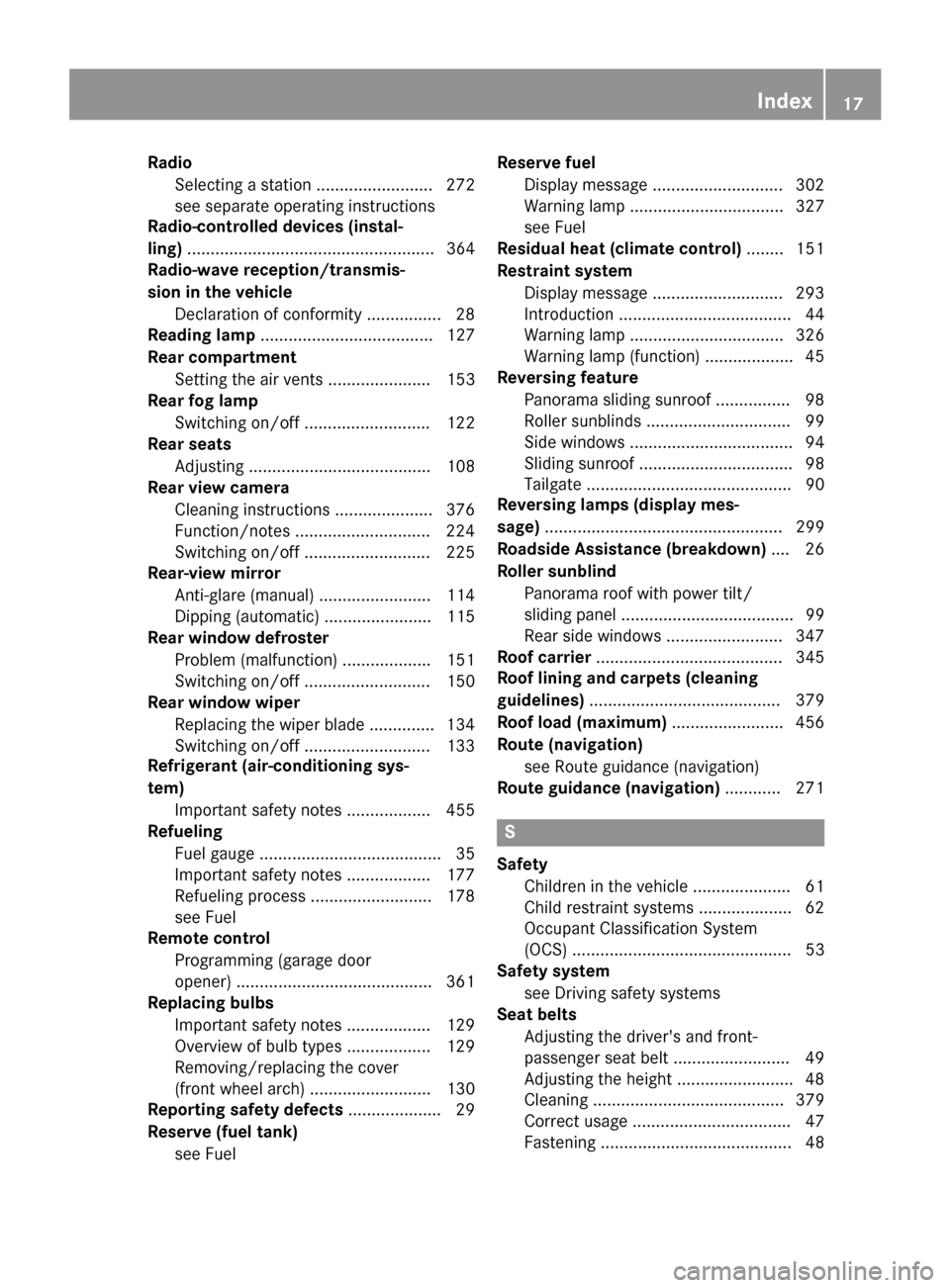
Radio
Selecting a station ......................... 272
see separate operating instructions
Radio-controlled devices (instal-
ling) ..................................................... 364
Radio-wave reception/transmis-
sion in the vehicle Declaration of conformity ................ 28
Reading lamp ..................................... 127
Rear compartment Setting the air vents ...................... 153
Rear fog lamp
Switching on/off ........................... 122
Rear seats
Adjusting ....................................... 108
Rear view camera
Cleaning instructions ..................... 376
Function/notes ............................ .224
Switching on/off ........................... 225
Rear-view mirror
Anti-glare (manual) ........................ 114
Dipping (automatic) ....................... 115
Rear window defroster
Problem (malfunction) ................... 151
Switching on/off ........................... 150
Rear window wiper
Replacing the wiper blade .............. 134
Switching on/off ........................... 133
Refrigerant (air-conditioning sys-
tem)
Important safety notes .................. 455
Refueling
Fuel gauge ....................................... 35
Important safety notes .................. 177
Refueling process .......................... 178
see Fuel
Remote control
Programming (garage door
opener) .......................................... 361
Replacing bulbs
Important safety notes .................. 129
Overview of bulb type s.................. 129
Removing/replacing the cover
(front wheel arch) .......................... 130
Reporting safety defects .................... 29
Reserve (fuel tank) see Fuel Reserve fuel
Display message ............................ 302
Warning lamp ................................. 327
see Fuel
Residual heat (climate control) ........ 151
Restraint system Display message ............................ 293
Introduction ..................................... 44
Warning lamp ................................. 326
Warning lamp (function) ................... 45
Reversing feature
Panorama sliding sunroo f................ 98
Roller sunblind s............................... 99
Side windows ................................... 94
Sliding sunroof ................................. 98
Tailgate ............................................ 90
Reversing lamps (display mes-
sage) ................................................... 299
Roadside Assistance (breakdown) .... 26
Roller sunblind Panorama roof with power tilt/
sliding panel ..................................... 99
Rear side window s......................... 347
Roof carrier ........................................ 345
Roof lining and carpets (cleaning
guidelines) ......................................... 379
Roof load (maximum) ........................ 456
Route (navigation) see Route guidance (navigation)
Route guidance (navigation) ............ 271 S
Safety Children in the vehicle ..................... 61
Child restraint systems .................... 62
Occupant Classification System
(OCS) ............................................... 53
Safety system
see Driving safety systems
Seat belts
Adjusting the driver's and front-
passenger seat belt ......................... 49
Adjusting the height ......................... 48
Cleaning ......................................... 379
Correct usage .................................. 47
Fastening ......................................... 48 Index
17
Page 20 of 466
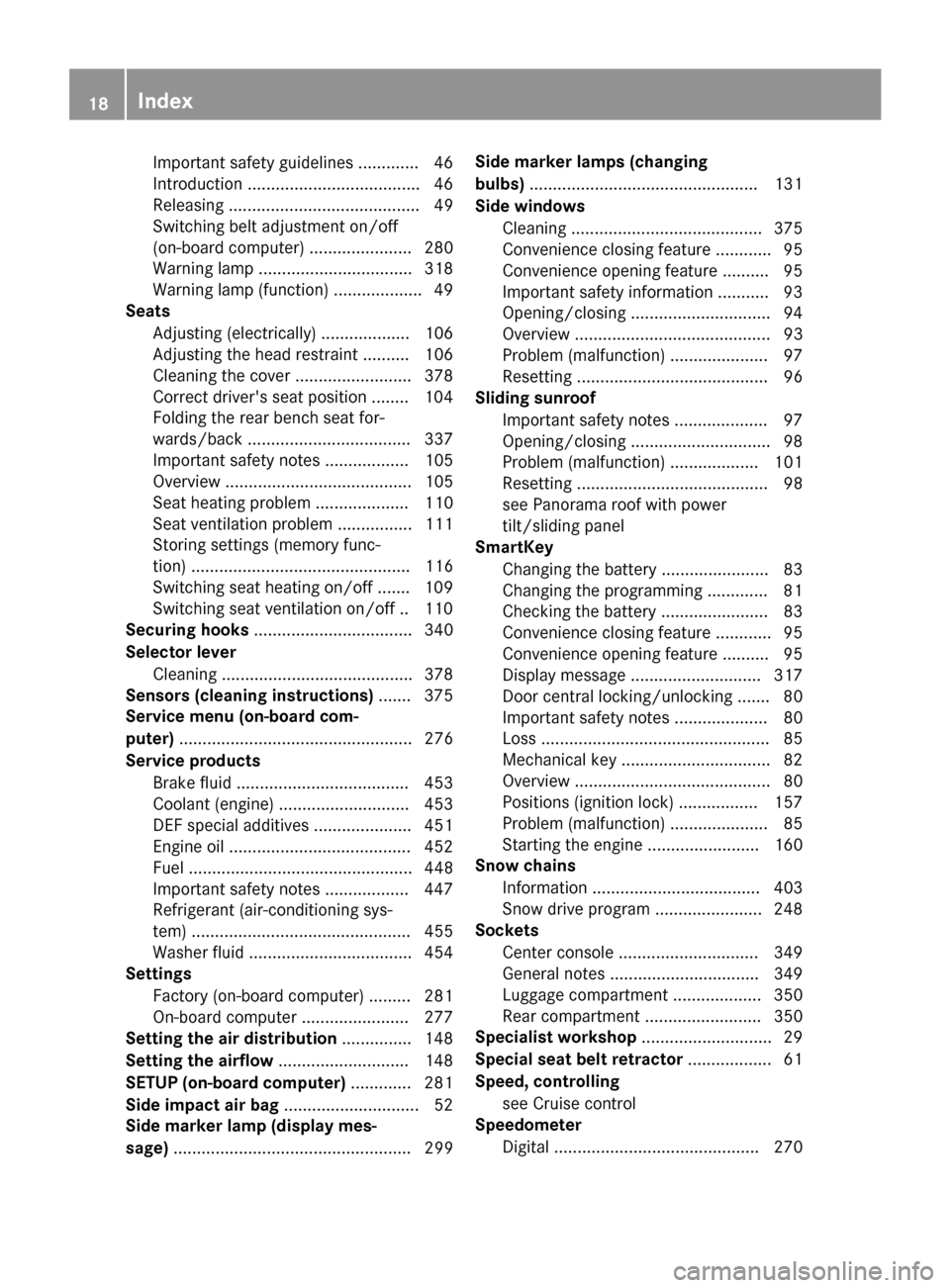
Important safety guidelines .............46
Introduction .....................................46
Releasin g......................................... 49
Switching belt adjustment on/off
(on-board computer) ...................... 280
Warning lamp ................................. 318
Warning lamp (function) ................... 49
Seats
Adjusting (electrically) ................... 106
Adjusting the head restraint .......... 106
Cleaning the cover ......................... 378
Correct driver's seat position ........ 104
Folding the rear bench seat for-
wards/back ................................... 337
Important safety notes .................. 105
Overview ........................................ 105
Seat heating problem .................... 110
Seat ventilation problem ................ 111
Storing settings (memory func-
tion) ............................................... 116
Switching seat heating on/of f....... 109
Switching seat ventilation on/of f.. 110
Securing hooks .................................. 340
Selector lever Cleaning ......................................... 378
Sensors (cleaning instructions) ....... 375
Service menu (on-board com-
puter) .................................................. 276
Service products Brake fluid ..................................... 453
Coolant (engine) ............................ 453
DEF special additives ..................... 451
Engine oil ....................................... 452
Fuel ................................................ 448
Important safety notes .................. 447
Refrigerant (air-conditioning sys-
tem) ............................................... 455
Washer fluid ................................... 454
Settings
Factory (on-board computer) ......... 281
On-board computer ....................... 277
Setting the air distribution ............... 148
Setting the airflow ............................ 148
SETUP (on-board computer) ............. 281
Side impact air bag ............................. 52
Side marker lamp (display mes-
sage) ................................................... 299 Side marker lamps (changing
bulbs)
................................................. 131
Side windows Cleaning ......................................... 375
Convenience closing feature ............ 95
Convenience opening feature .......... 95
Important safety information ........... 93
Opening/closing .............................. 94
Overview .......................................... 93
Problem (malfunction) ..................... 97
Resetting ......................................... 96
Sliding sunroof
Important safety notes .................... 97
Opening/closing .............................. 98
Problem (malfunction) ................... 101
Resetting ......................................... 98
see Panorama roof with power
tilt/sliding panel
SmartKey
Changing the battery ....................... 83
Changing the programming ............. 81
Checking the battery ....................... 83
Convenience closing feature ............ 95
Convenience opening feature .......... 95
Display message ............................ 317
Door central locking/unlocking ....... 80
Important safety notes .................... 80
Loss ................................................. 85
Mechanical key ................................ 82
Overview .......................................... 80
Positions (ignition lock) ................. 157
Problem (malfunction) ..................... 85
Starting the engine ........................ 160
Snow chains
Information .................................... 403
Snow drive program ....................... 248
Sockets
Center console .............................. 349
General notes ................................ 349
Luggage compartment ................... 350
Rear compartment ......................... 350
Specialist workshop ............................ 29
Special seat belt retractor .................. 61
Speed, controlling see Cruise control
Speedometer
Digital ............................................ 270 18
Index
Page 26 of 466
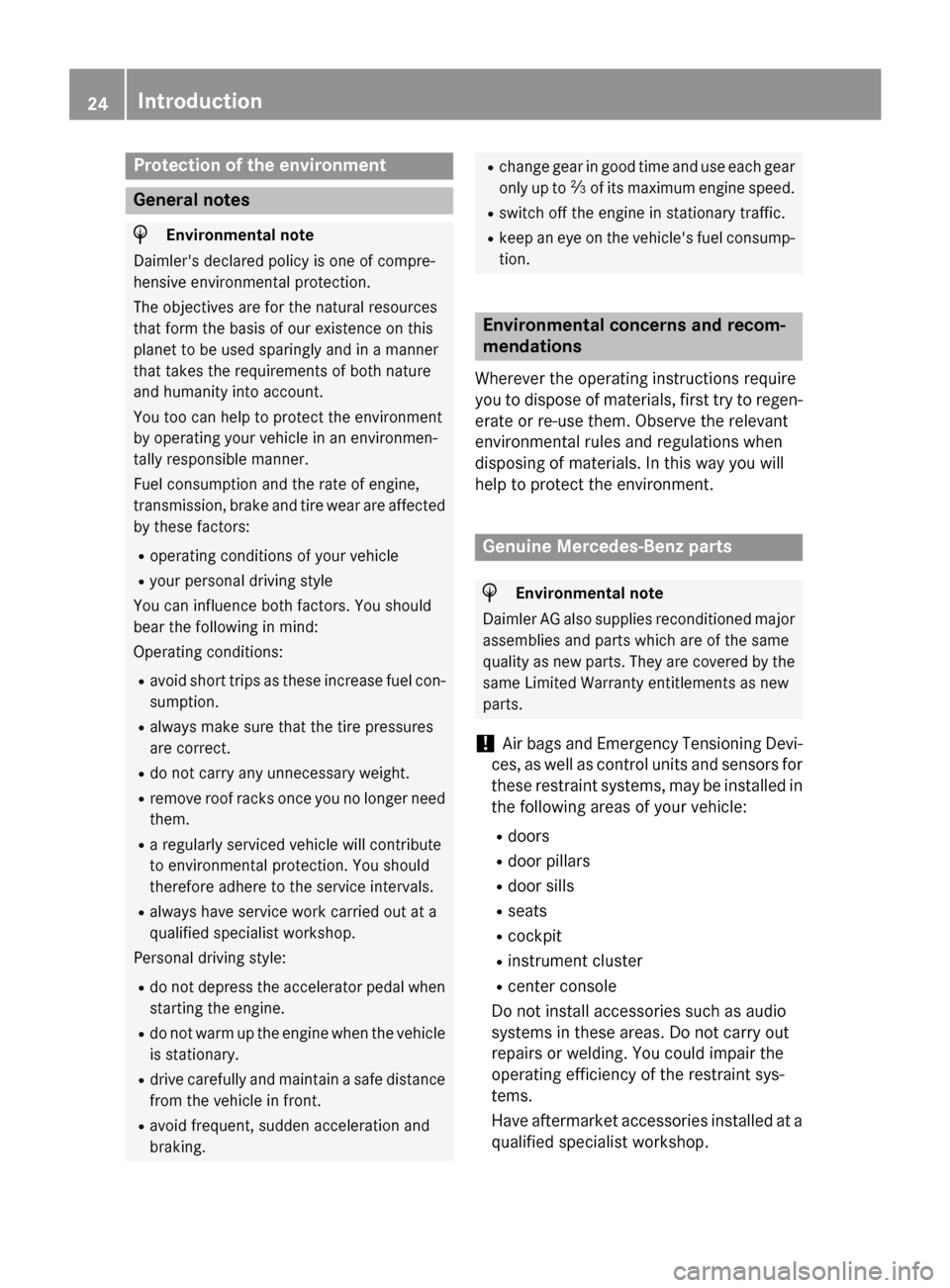
Protection of the environment
General notes
H
Environmental note
Daimler's declared policy is one of compre-
hensive environmental protection.
The objectives are for the natural resources
that form the basis of our existence on this
planet to be used sparingly and in a manner
that takes the requirements of both nature
and humanity into account.
You too can help to protect the environment
by operating your vehicle in an environmen-
tally responsible manner.
Fuel consumption and the rate of engine,
transmission, brake and tire wear are affected by these factors:
R operating conditions of your vehicle
R your personal driving style
You can influence both factors. You should
bear the following in mind:
Operating conditions:
R avoid short trips as these increase fuel con-
sumption.
R always make sure that the tire pressures
are correct.
R do not carry any unnecessary weight.
R remove roof racks once you no longer need
them.
R a regularly serviced vehicle will contribute
to environmental protection. You should
therefore adhere to the service intervals.
R always have service work carried out at a
qualified specialist workshop.
Personal driving style:
R do not depress the accelerator pedal when
starting the engine.
R do not warm up the engine when the vehicle
is stationary.
R drive carefully and maintain a safe distance
from the vehicle in front.
R avoid frequent, sudden acceleration and
braking. R
change gear in good time and use each gear
only up to 00C3of its maximum engine speed.
R switch off the engine in stationary traffic.
R keep an eye on the vehicle's fuel consump-
tion. Environmental concerns and recom-
mendations
Wherever the operating instructions require
you to dispose of materials, first try to regen-
erate or re-use them. Observe the relevant
environmental rules and regulations when
disposing of materials. In this way you will
help to protect the environment. Genuine Mercedes-Benz parts
H
Environmental note
Daimler AG also supplies reconditioned major
assemblies and parts which are of the same
quality as new parts. They are covered by the same Limited Warranty entitlements as new
parts.
! Air bags and Emergency Tensioning Devi-
ces, as well as control units and sensors for these restraint systems, may be installed inthe following areas of your vehicle:
R doors
R door pillars
R door sills
R seats
R cockpit
R instrument cluster
R center console
Do not install accessories such as audio
systems in these areas. Do not carry out
repairs or welding. You could impair the
operating efficiency of the restraint sys-
tems.
Have aftermarket accessories installed at a qualified specialist workshop. 24
Introduction
Page 44 of 466
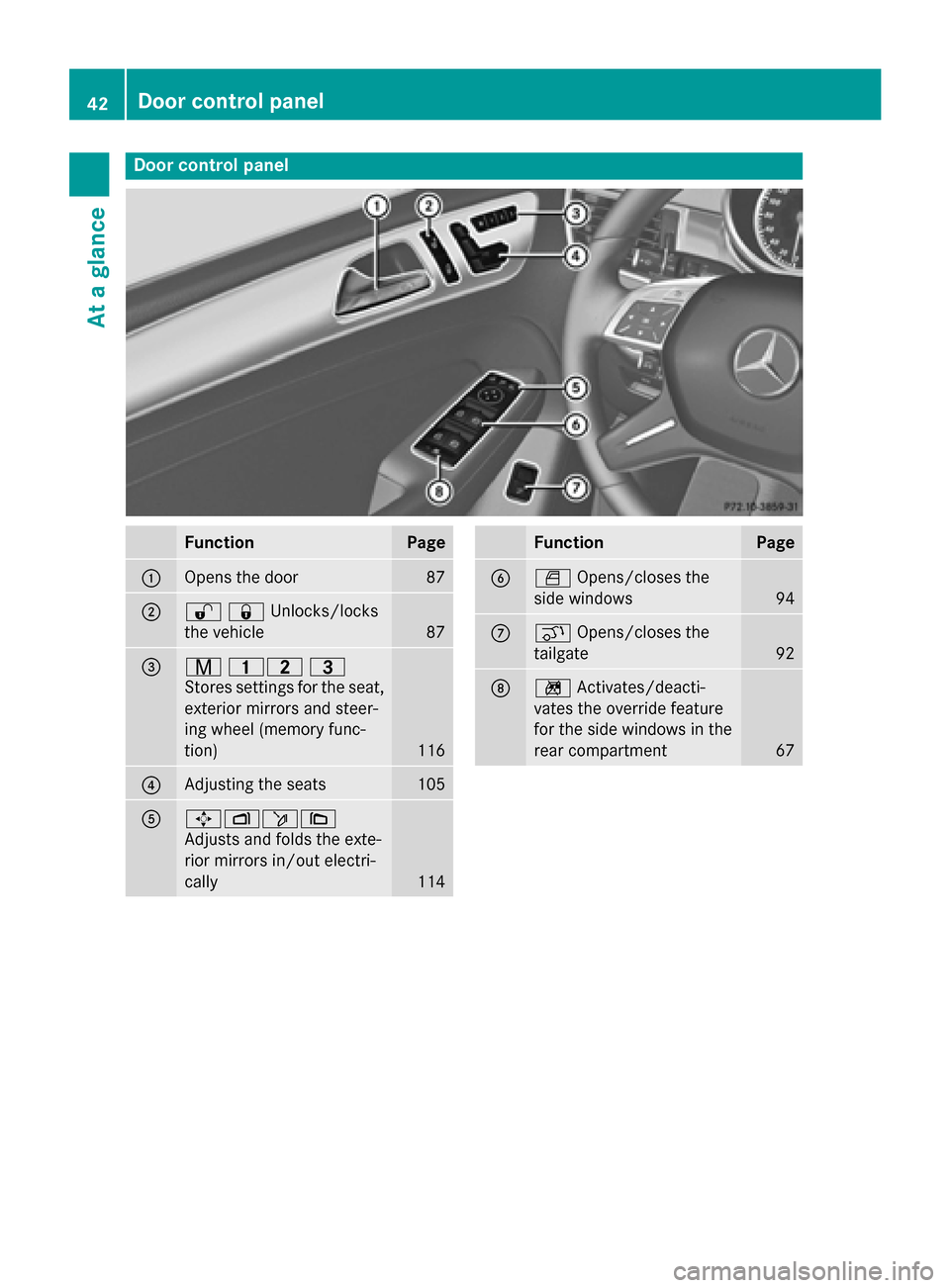
Door control panel
Function Page
0043
Opens the door 87
0044
00360037Unlocks/locks
the vehicle 87
0087
008D
00370038
Stores settings for the seat, exterior mirrors and steer-
ing wheel (memory func-
tion) 116
0085
Adjusting the seats 105
0083
0062007000F50071
Adjusts and folds the exte-
rior mirrors in/out electri-
cally
114 Function Page
0084
0062
Opens/closes the
side windows 94
006B
008C
Opens/closes the
tailgate 92
006C
0089
Activates/deacti-
vates the override feature
for the side windows in the
rear compartment 6742
Door control panelAt a glance
Page 48 of 466
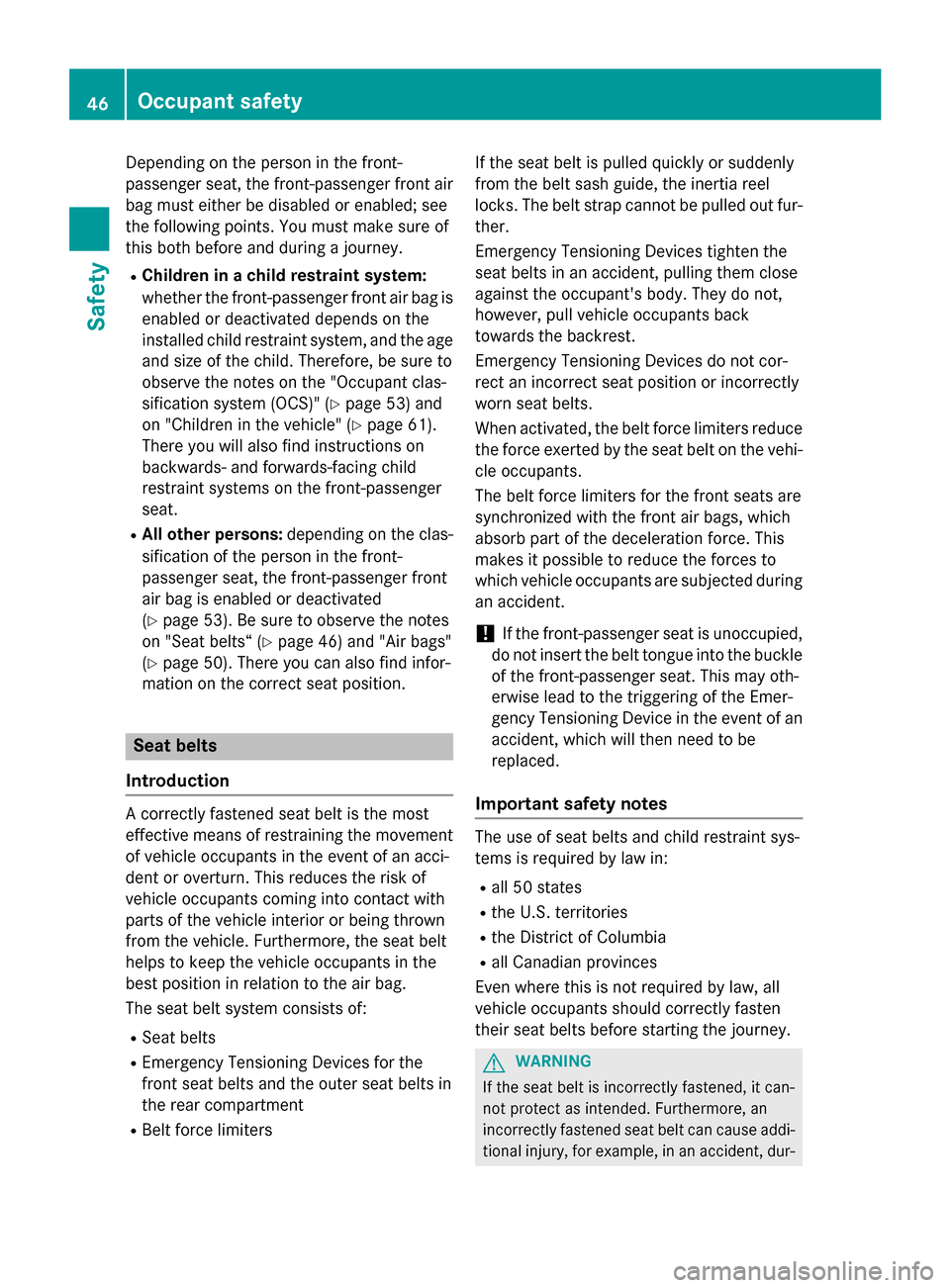
Depending on the person in the front-
passenger seat, the front-passenger front air
bag must either be disabled or enabled; see
the following points. You must make sure of
this both before and during a journey.
R Children in a child restraint system:
whether the front-passenger front air bag is
enabled or deactivated depends on the
installed child restraint system, and the age
and size of the child. Therefore, be sure to
observe the notes on the "Occupant clas-
sification system (OCS)" (Y page 53) and
on "Children in the vehicle" (Y page 61).
There you will also find instructions on
backwards- and forwards-facing child
restraint systems on the front-passenger
seat.
R All other persons: depending on the clas-
sification of the person in the front-
passenger seat, the front-passenger front
air bag is enabled or deactivated
(Y page 53). Be sure to observe the notes
on "Seat belts“ (Y page 46) and "Air bags"
(Y page 50). There you can also find infor-
mation on the correct seat position. Seat belts
Introduction A correctly fastened seat belt is the most
effective means of restraining the movement
of vehicle occupants in the event of an acci-
dent or overturn. This reduces the risk of
vehicle occupants coming into contact with
parts of the vehicle interior or being thrown
from the vehicle. Furthermore, the seat belt
helps to keep the vehicle occupants in the
best position in relation to the air bag.
The seat belt system consists of:
R Seat belts
R Emergency Tensioning Devices for the
front seat belts and the outer seat belts in
the rear compartment
R Belt force limiters If the seat belt is pulled quickly or suddenly
from the belt sash guide, the inertia reel
locks. The belt strap cannot be pulled out fur-
ther.
Emergency Tensioning Devices tighten the
seat belts in an accident, pulling them close
against the occupant's body. They do not,
however, pull vehicle occupants back
towards the backrest.
Emergency Tensioning Devices do not cor-
rect an incorrect seat position or incorrectly
worn seat belts.
When activated, the belt force limiters reduce
the force exerted by the seat belt on the vehi-
cle occupants.
The belt force limiters for the front seats are
synchronized with the front air bags, which
absorb part of the deceleration force. This
makes it possible to reduce the forces to
which vehicle occupants are subjected during an accident.
! If the front-passenger seat is unoccupied,
do not insert the belt tongue into the buckle of the front-passenger seat. This may oth-
erwise lead to the triggering of the Emer-
gency Tensioning Device in the event of anaccident, which will then need to be
replaced.
Important safety notes The use of seat belts and child restraint sys-
tems is required by law in:
R all 50 states
R the U.S. territories
R the District of Columbia
R all Canadian provinces
Even where this is not required by law, all
vehicle occupants should correctly fasten
their seat belts before starting the journey. G
WARNING
If the seat belt is incorrectly fastened, it can-
not protect as intended. Furthermore, an
incorrectly fastened seat belt can cause addi- tional injury, for example, in an accident, dur- 46
Occupant safetySafety
Page 52 of 466
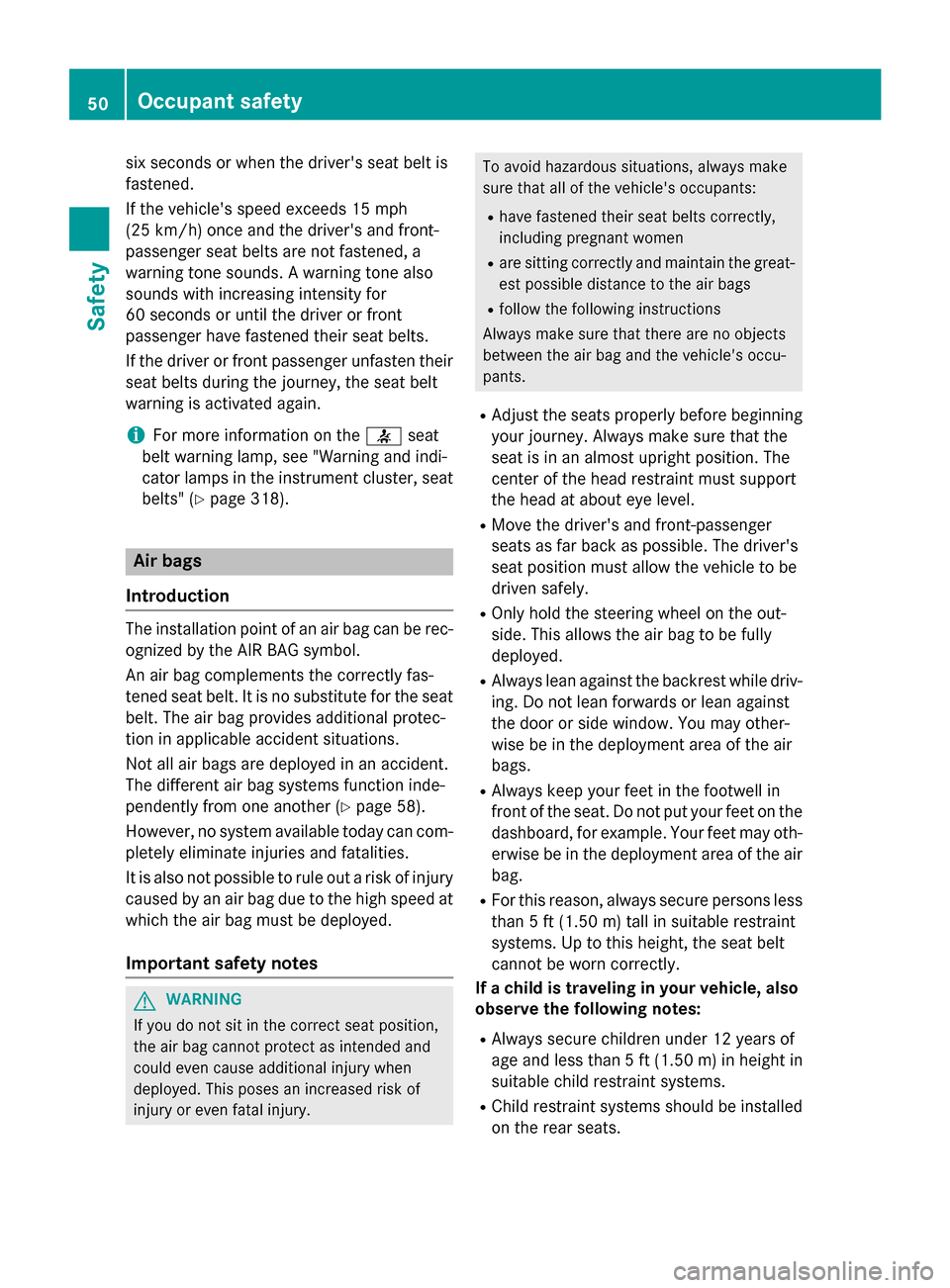
six seconds or when the driver's seat belt is
fastened.
If the vehicle's speed exceeds 15 mph
(25 km/h) once and the driver's and front-
passenger seat belts are not fastened, a
warning tone sounds. A warning tone also
sounds with increasing intensity for
60 seconds or until the driver or front
passenger have fastened their seat belts.
If the driver or front passenger unfasten their seat belts during the journey, the seat belt
warning is activated again.
i For more information on the
0076seat
belt warning lamp, see "Warning and indi-
cator lamps in the instrument cluster, seat
belts" (Y page 318). Air bags
Introduction The installation point of an air bag can be rec-
ognized by the AIR BAG symbol.
An air bag complements the correctly fas-
tened seat belt. It is no substitute for the seat
belt. The air bag provides additional protec-
tion in applicable accident situations.
Not all air bags are deployed in an accident.
The different air bag systems function inde-
pendently from one another (Y page 58).
However, no system available today can com- pletely eliminate injuries and fatalities.
It is also not possible to rule out a risk of injury
caused by an air bag due to the high speed at which the air bag must be deployed.
Important safety notes G
WARNING
If you do not sit in the correct seat position,
the air bag cannot protect as intended and
could even cause additional injury when
deployed. This poses an increased risk of
injury or even fatal injury. To avoid hazardous situations, always make
sure that all of the vehicle's occupants:
R have fastened their seat belts correctly,
including pregnant women
R are sitting correctly and maintain the great-
est possible distance to the air bags
R follow the following instructions
Always make sure that there are no objects
between the air bag and the vehicle's occu-
pants.
R Adjust the seats properly before beginning
your journey. Always make sure that the
seat is in an almost upright position. The
center of the head restraint must support
the head at about eye level.
R Move the driver's and front-passenger
seats as far back as possible. The driver's
seat position must allow the vehicle to be
driven safely.
R Only hold the steering wheel on the out-
side. This allows the air bag to be fully
deployed.
R Always lean against the backrest while driv-
ing. Do not lean forwards or lean against
the door or side window. You may other-
wise be in the deployment area of the air
bags.
R Always keep your feet in the footwell in
front of the seat. Do not put your feet on the
dashboard, for example. Your feet may oth- erwise be in the deployment area of the air
bag.
R For this reason, always secure persons less
than 5 ft (1.50 m) tall in suitable restraint
systems. Up to this height, the seat belt
cannot be worn correctly.
If a child is traveling in your vehicle, also
observe the following notes:
R Always secure children under 12 years of
age and less than 5 ft (1.50 m)in height in
suitable child restraint systems.
R Child restraint systems should be installed
on the rear seats. 50
Occupant safetySafety
Page 53 of 466
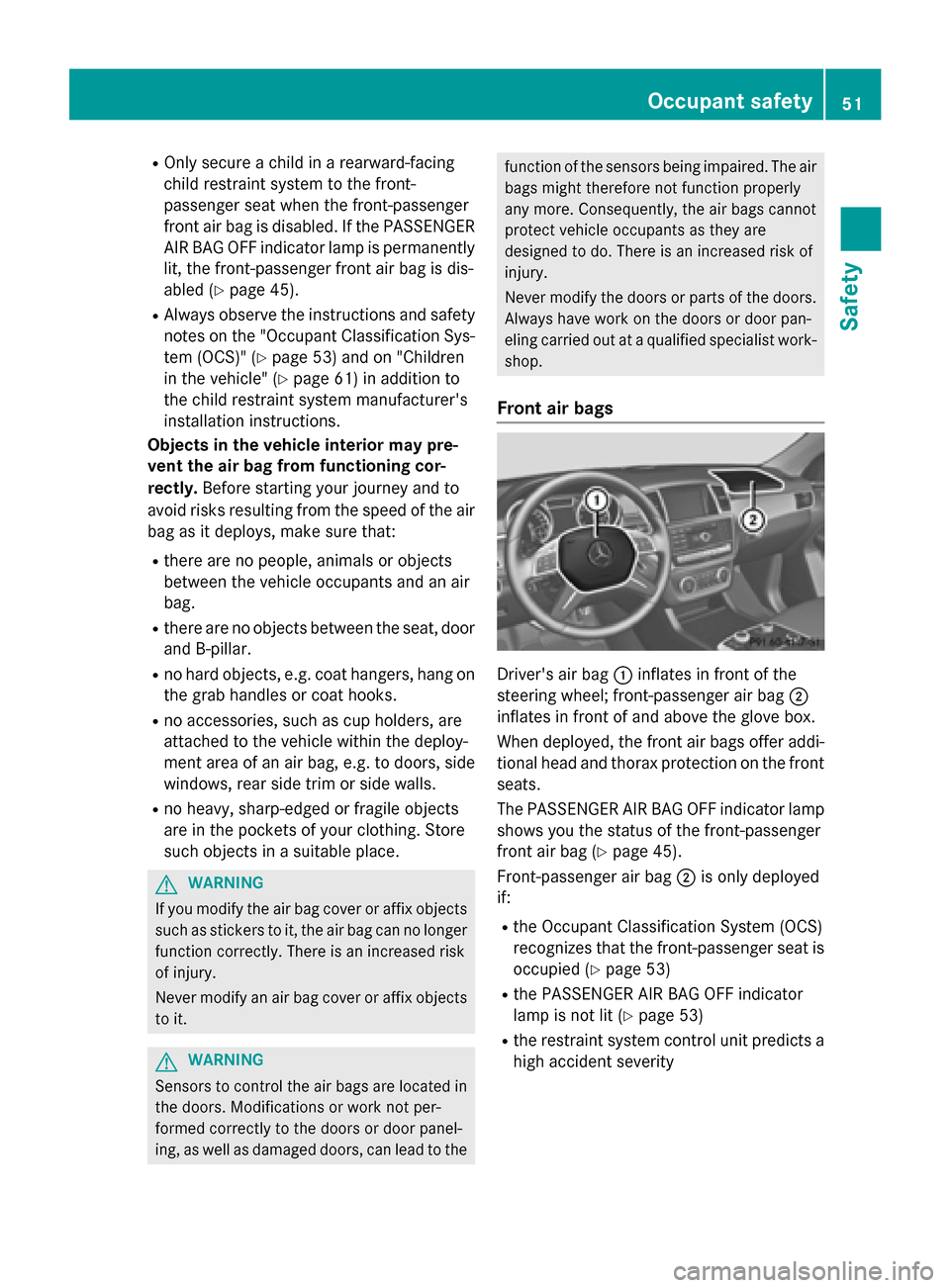
R
Only secure a child in a rearward-facing
child restraint system to the front-
passenger seat when the front-passenger
front air bag is disabled. If the PASSENGER
AIR BAG OFF indicator lamp is permanently
lit, the front-passenger front air bag is dis-
abled (Y page 45).
R Always observe the instructions and safety
notes on the "Occupant Classification Sys-
tem (OCS)" (Y page 53) and on "Children
in the vehicle" (Y page 61) in addition to
the child restraint system manufacturer's
installation instructions.
Objects in the vehicle interior may pre-
vent the air bag from functioning cor-
rectly. Before starting your journey and to
avoid risks resulting from the speed of the air bag as it deploys, make sure that:
R there are no people, animals or objects
between the vehicle occupants and an air
bag.
R there are no objects between the seat, door
and B-pillar.
R no hard objects, e.g. coat hangers, hang on
the grab handles or coat hooks.
R no accessories, such as cup holders, are
attached to the vehicle within the deploy-
ment area of an air bag, e.g. to doors, side windows, rear side trim or side walls.
R no heavy, sharp-edged or fragile objects
are in the pockets of your clothing. Store
such objects in a suitable place. G
WARNING
If you modify the air bag cover or affix objects
such as stickers to it, the air bag can no longer function correctly. There is an increased risk
of injury.
Never modify an air bag cover or affix objectsto it. G
WARNING
Sensors to control the air bags are located in the doors. Modifications or work not per-
formed correctly to the doors or door panel-
ing, as well as damaged doors, can lead to the function of the sensors being impaired. The air
bags might therefore not function properly
any more. Consequently, the air bags cannot
protect vehicle occupants as they are
designed to do. There is an increased risk of
injury.
Never modify the doors or parts of the doors.
Always have work on the doors or door pan-
eling carried out at a qualified specialist work- shop.
Front air bags Driver's air bag
0043inflates in front of the
steering wheel; front-passenger air bag 0044
inflates in front of and above the glove box.
When deployed, the front air bags offer addi-
tional head and thorax protection on the front
seats.
The PASSENGER AIR BAG OFF indicator lamp shows you the status of the front-passenger
front air bag (Y page 45).
Front-passenger air bag 0044is only deployed
if:
R the Occupant Classification System (OCS)
recognizes that the front-passenger seat is
occupied (Y page 53)
R the PASSENGER AIR BAG OFF indicator
lamp is not lit (Y page 53)
R the restraint system control unit predicts a
high accident severity Occupant safety
51Safety Z
Page 54 of 466
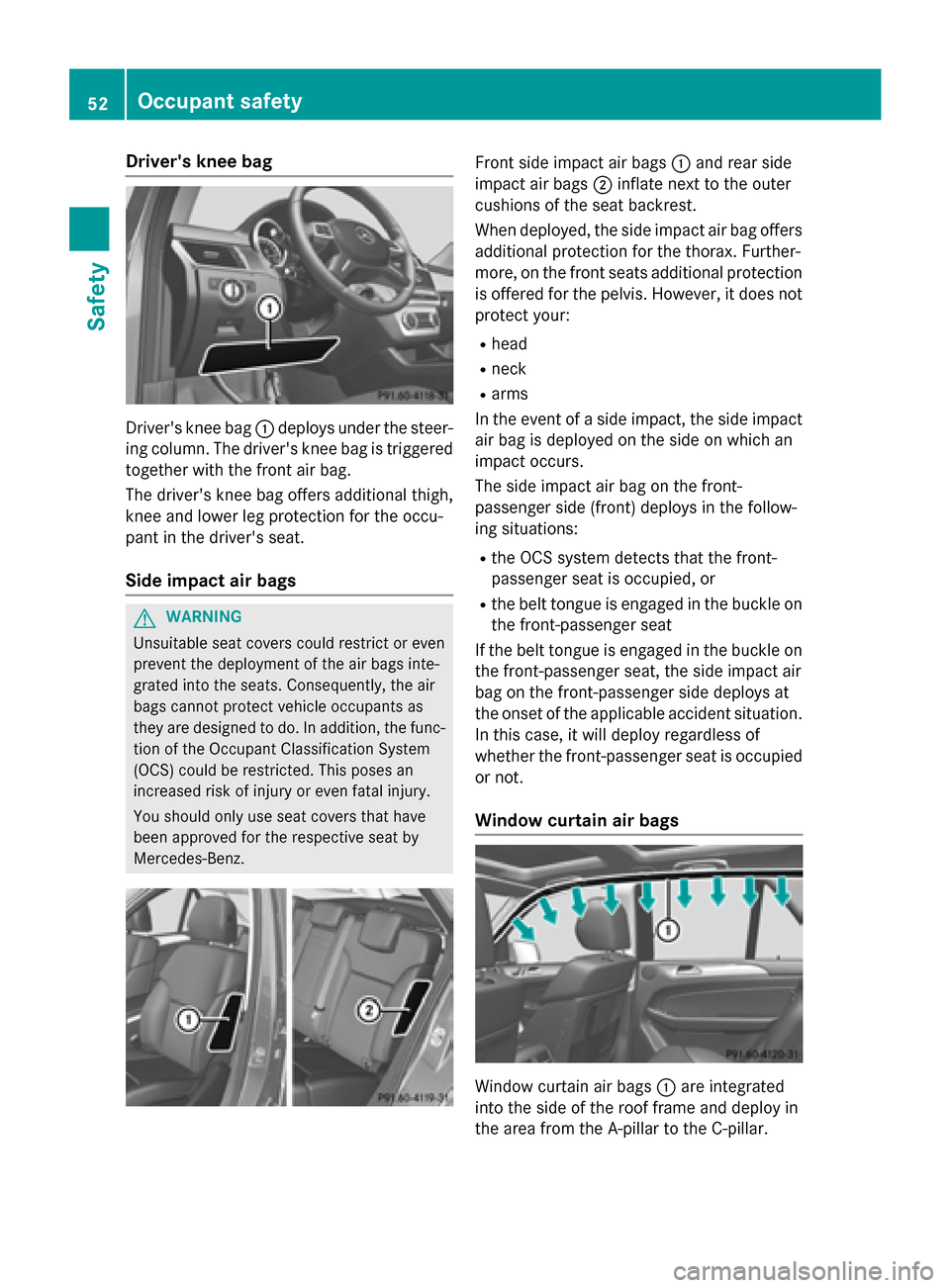
Driver's knee bag
Driver's knee bag
0043deploys under the steer-
ing column. The driver's knee bag is triggered
together with the front air bag.
The driver's knee bag offers additional thigh,
knee and lower leg protection for the occu-
pant in the driver's seat.
Side impact air bags G
WARNING
Unsuitable seat covers could restrict or even
prevent the deployment of the air bags inte-
grated into the seats. Consequently, the air
bags cannot protect vehicle occupants as
they are designed to do. In addition, the func- tion of the Occupant Classification System
(OCS) could be restricted. This poses an
increased risk of injury or even fatal injury.
You should only use seat covers that have
been approved for the respective seat by
Mercedes-Benz. Front side impact air bags
0043and rear side
impact air bags 0044inflate next to the outer
cushions of the seat backrest.
When deployed, the side impact air bag offers additional protection for the thorax. Further-
more, on the front seats additional protection
is offered for the pelvis. However, it does not protect your:
R head
R neck
R arms
In the event of a side impact, the side impact
air bag is deployed on the side on which an
impact occurs.
The side impact air bag on the front-
passenger side (front) deploys in the follow-
ing situations:
R the OCS system detects that the front-
passenger seat is occupied, or
R the belt tongue is engaged in the buckle on
the front-passenger seat
If the belt tongue is engaged in the buckle on the front-passenger seat, the side impact air
bag on the front-passenger side deploys at
the onset of the applicable accident situation. In this case, it will deploy regardless of
whether the front-passenger seat is occupied
or not.
Window curtain air bags Window curtain air bags
0043are integrated
into the side of the roof frame and deploy in
the area from the A-pillar to the C-pillar. 52
Occupant safetySafety
Page 61 of 466
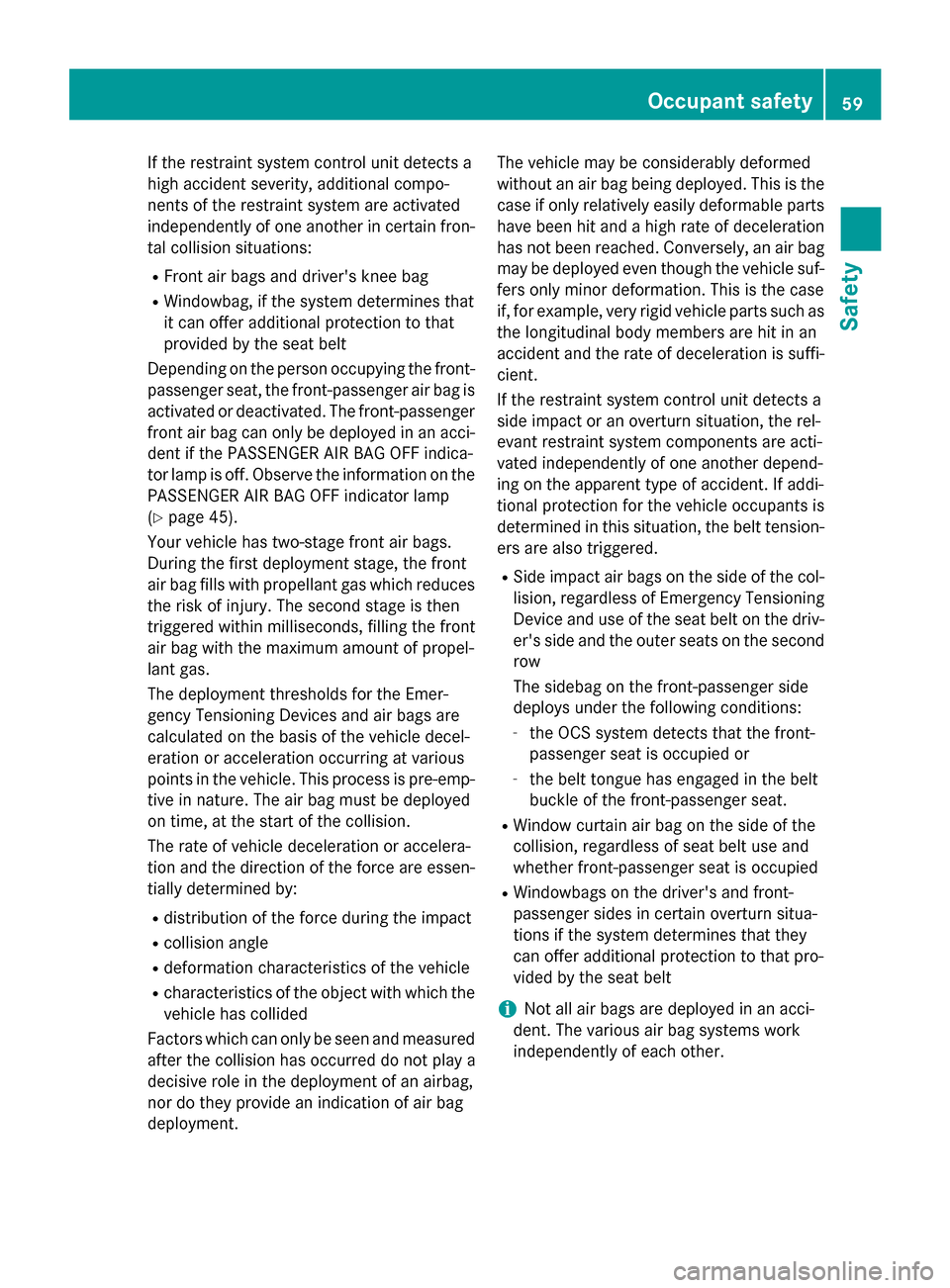
If the restraint system control unit detects a
high accident severity, additional compo-
nents of the restraint system are activated
independently of one another in certain fron- tal collision situations:
R Front air bags and driver's knee bag
R Windowbag, if the system determines that
it can offer additional protection to that
provided by the seat belt
Depending on the person occupying the front-
passenger seat, the front-passenger air bag is activated or deactivated. The front-passenger front air bag can only be deployed in an acci-
dent if the PASSENGER AIR BAG OFF indica-
tor lamp is off. Observe the information on the
PASSENGER AIR BAG OFF indicator lamp
(Y page 45).
Your vehicle has two-stage front air bags.
During the first deployment stage, the front
air bag fills with propellant gas which reduces
the risk of injury. The second stage is then
triggered within milliseconds, filling the front
air bag with the maximum amount of propel-
lant gas.
The deployment thresholds for the Emer-
gency Tensioning Devices and air bags are
calculated on the basis of the vehicle decel-
eration or acceleration occurring at various
points in the vehicle. This process is pre-emp- tive in nature. The air bag must be deployed
on time, at the start of the collision.
The rate of vehicle deceleration or accelera-
tion and the direction of the force are essen-
tially determined by:
R distribution of the force during the impact
R collision angle
R deformation characteristics of the vehicle
R characteristics of the object with which the
vehicle has collided
Factors which can only be seen and measured
after the collision has occurred do not play a
decisive role in the deployment of an airbag,
nor do they provide an indication of air bag
deployment. The vehicle may be considerably deformed
without an air bag being deployed. This is the
case if only relatively easily deformable parts
have been hit and a high rate of deceleration
has not been reached. Conversely, an air bag may be deployed even though the vehicle suf-
fers only minor deformation. This is the case
if, for example, very rigid vehicle parts such as
the longitudinal body members are hit in an
accident and the rate of deceleration is suffi-
cient.
If the restraint system control unit detects a
side impact or an overturn situation, the rel-
evant restraint system components are acti-
vated independently of one another depend-
ing on the apparent type of accident. If addi-
tional protection for the vehicle occupants is determined in this situation, the belt tension-
ers are also triggered.
R Side impact air bags on the side of the col-
lision, regardless of Emergency Tensioning
Device and use of the seat belt on the driv-
er's side and the outer seats on the second row
The sidebag on the front-passenger side
deploys under the following conditions:
- the OCS system detects that the front-
passenger seat is occupied or
- the belt tongue has engaged in the belt
buckle of the front-passenger seat.
R Window curtain air bag on the side of the
collision, regardless of seat belt use and
whether front-passenger seat is occupied
R Windowbags on the driver's and front-
passenger sides in certain overturn situa-
tions if the system determines that they
can offer additional protection to that pro-
vided by the seat belt
i Not all air bags are deployed in an acci-
dent. The various air bag systems work
independently of each other. Occupant safety
59Safety Z